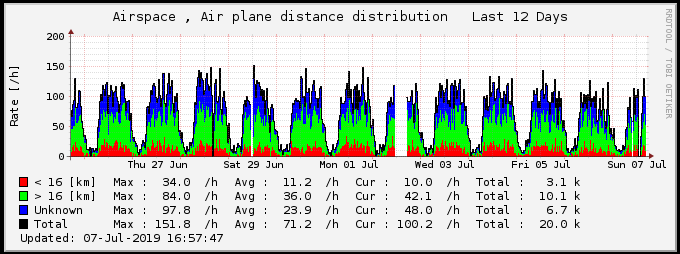The aim of this project is to have a stand-alone system which determines at which distances the air planes are flying by. The hardware consists of a Raspberry Pi 0W, a USB attached SDR and an antenna. Program dump1090 is used to read the ADS-B messages transmitted by air planes in the neighbourhood. Those messages are passed on to python script detapd.py, which determines the minimal distance between the air plane and a reference point while the plane is flying by. Once the message stream of an air plane has ceased, the parameters are logged.
A simple distribution of the distances is build. For this distribution, seven classes are defined:
- The air plane does not emit it's position, thus the distance is unknown;
- The minimal distance is up to 1 [km];
- The minimal distance is between 1 and 2 [km];
- The minimal distance is between 2 and 4 [km];
- The minimal distance is between 4 and 8 [km];
- The minimal distance is between 8 and 16 [km]; and
- The minimal distance is more than 16 [km].
The reference point should be nearby the receiver, for obvious reasons.
The results are reported to a Xymon server, which takes care of saving the distribution data and generating the graphs.
Download script detapd.py and save it at a convenient location on your Raspberry Pi. It is advised to use a separate map, as a log of planes having passed is created in the directory in which the script is located. (Note: 'detapd' is short for 'DETermine_Air_Plane_Distance'.)
At the beginning of script detapd.py there is a section entitled "Configuration parameters". In this section two items need to be set.
The first one is the (location of the) reference point. This location is normally the location of the receiver. As the messages of air planes up to tens of kilometres away can be received even with the simplest of antennas, a reasonable accurate result can be obtained if the distance between the reference point and the location of the receiver is less than a few kilometres.
The second item to set is the invocation of program dump1090. If socket TCP/30003 is not available, script detapd.py uses this definition to start program dump1090. The path to this program needs to be set.
After setting these configation parameters, the script is ready to go.
The three graphs below show the results as collected and presented by Xymon. They all show averages over an half hour. Thus a measurement showing a message rate of 50 messages per second implies the reception of 50 * 1800 = 90000 messages.
The distribution of distances is shown in two graphs. The first one shows three groups: distance unknown, a (shortest) distance larger than 16 [km] and a distance shorter than 16 [km]. The second graph shows a further division of the last group into four subgroups: a (shortest) distance of less than 2 [km], a distance between 2 and 4 [km], a distance between 4 and 8 [km] and a distance between 8 and 16 [km].


